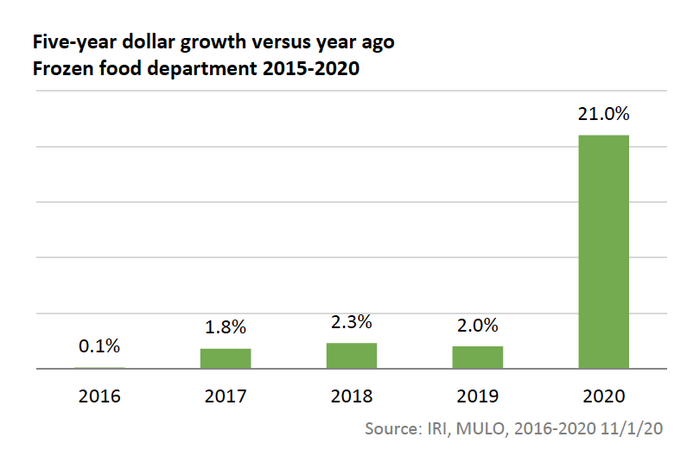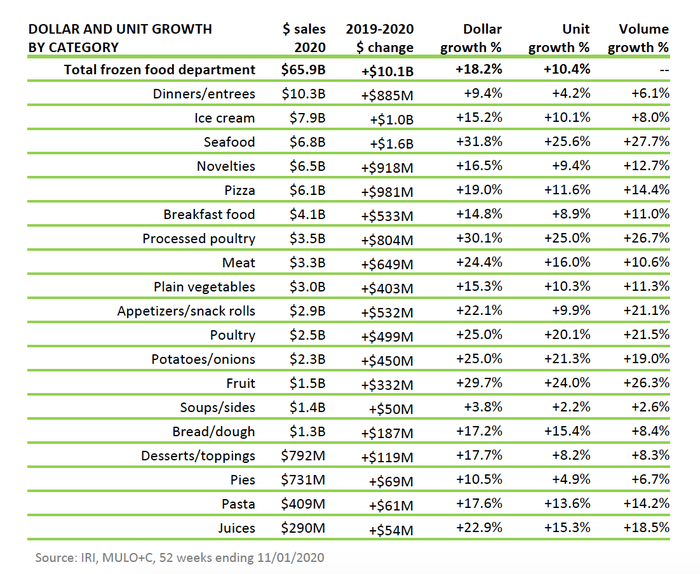Frozen food sales up 21% in 2020 as COVID-19 alters shopping and eating behaviorsFrozen food sales up 21% in 2020 as COVID-19 alters shopping and eating behaviors
Category is a "pandemic powerhouse," says The Power of Frozen report from AFFI and FMI.
February 24, 2021

A new report from the American Frozen Food Institute and the Food Industry Association (FMI) finds frozen foods were among the fastest-growing categories in the grocery store during COVID-19, with clear signs that the trend toward frozen will continue to grow beyond the pandemic.
The Power of Frozen 2021 identifies megatrends influencing the demand for frozen foods, including increased engagement in all categories, online shopping and health and wellbeing.
“The frozen food aisle has been a growth driver for retailers since 2016 with acceleration ahead of most other departments,” said AFFI president and CEO Alison Bodor. “Frozen foods are a pandemic powerhouse ringing in $65.1 billion in retail sales in 2020, a 21% increase compared to a year ago.”
In 2020 frozen food sales grew in both dollars (+21%) and units (+13.3%), with nearly all types of frozen foods seeing double-digit sales increases.
“Shoppers are nearly a year into the COVID-19 pandemic and are having more family meals at home than ever before. They are looking for meal plans, culinary creativity and convenient, cost-effective solutions,” said FMI Vice President of Industry Relations Doug Baker. “The frozen foods category offers these benefits to shoppers and that’s why we see all areas—from meal ingredients to meal solutions—reaching new audiences and increasing purchases.”

During the early weeks of the pandemic in mid and late March, frozen food sales nearly doubled. In subsequent months, sales tracked 30% to 40% ahead of a year ago. Gains have slowly tapered off to around 15% to 20% above 2019 levels in the fourth quarter of 2020—continuing to be well ahead of most other in-store categories.
The top three frozen food categories with the largest percentage of dollar growth in 2020, according to IRI, include seafood (+35.3%), poultry (+34.7%) and appetizers (+28.9%).
“It’s not just about what’s for dinner, especially for our core frozen food consumers,” Bodor added. “All meal occasions—dinner, lunch, snacks and breakfast—are contributing to an increase in frozen food purchases.”

According to the report, Americans’ reliance on frozen food varies widely, from 13% consuming it once a month at most to 14% using frozen foods daily. Many consumers (72%) mix fresh and frozen ingredients in their meal preparation. Amid the pandemic, the share of core frozen food consumers, defined as those who consume frozen food daily or every few days, rose from 35% in 2018 to 39% in 2020. Core frozen food consumers grew among boomers, singles and women, but the older millennial remains the largest segment. Core frozen foods consumers purchase across more categories, particularly multi-serve entrees, meat/chicken, meat alternatives and potato items.
As consumers turned to online shopping at a record rate during COVID, the vast majority were adding frozen to their digital cart. Over the past year, 42% of households that buy frozen foods have bought frozen foods online, up from 23% in 2018. Online frozen food dollar sales increased 75% in 2020, with frozen dinners/entrees, meat, poultry and seafood being the biggest online sellers.
Across many nutrition and production traits, frozen food consumers are most likely to be interested in “real” ingredients, followed by fresh frozen and the absence of artificial colors.
The interest in fresh frozen also aligns with another key finding from the Power of Frozen 2021. To most frozen food consumers (72%), it’s not frozen or fresh—it’s frozen and fresh. “Mixing fresh and frozen in the same meal is a telltale trait of our core frozen food consumers,” noted Bodor.

Among other highlights from the Power of Frozen report:
• The COVID-19 pandemic prompted changes in purchasing: 57% still purchase more frozen foods, 58% different kinds of frozen foods or 57% are purchasing different brands than they did pre-pandemic.
• Both core and low-frequency frozen food consumers have become more engaged. Buying different items and buying more have a high correlation, underscoring that frozen foods’ vast variety can be one of its most effective recruiting grounds.
• Dinner, snacks and breakfast are top drivers of increased frozen food purchases since the onset of the pandemic. All areas, from meal ingredients to meal solutions have gained in new buyers and increased purchases. Areas of accelerated growth since April are seafood, fruit and multiserve meal solutions.
• Concerns over shortages or being in-store have greatly diminished since April, but frozen foods’ ease of preparation and more at-home meals are important drivers of buying more frozen foods.
• Greater levels of experimentation along with needing more variety for the more at-home meals and value seeking are driving shoppers to change the kinds of frozen foods they purchase.
• 38% of frozen food shoppers expect they will purchase more in the next few months versus 6% expecting to buy less.
The Power of Frozen was conducted by 210 Analytics and is sponsored by Pictsweet, Wawona Frozen Foods, J.R. Simplot Co. and Firestone Pacific Foods.
 This piece originally appeared on Supermarket News, a New Hope Network sister website. Visit the site for more grocery trends and insights.
This piece originally appeared on Supermarket News, a New Hope Network sister website. Visit the site for more grocery trends and insights.
About the Author
You May Also Like



